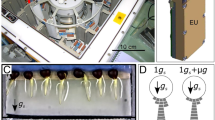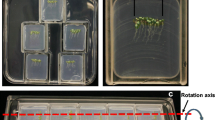Abstract
In the 1970s, when I started to work on gravitropism at the University Pierre and Marie Curie, Paris), it was well known that statocytes contain voluminous amyloplasts (statoliths) that sediment under the influence of gravity. The role of these organelles in gravisensing was strongly disputed. In 1974, I attended a session of a meeting on gravitropism in Würzburg, where I presented results that supported the involvement of statoliths in the perception of gravity. This meeting had a strong impact on my research, since at that time the Council of Europe was looking for people interested in performing experiments in Space. Our first experiment (ROOTS) was carried out in the Biorack Facility (ESA) in the frame of the Spacelab D1 mission (1985). We had a very efficient help from CNES which developed a very fine hardware to grow lentil seedlings and to chemically fix them at the end of the experiment. The results obtained were surprising since we observed that in microgravity the statoliths were located at one pole of the statocyte and not distributed at random as it was expected. The goal of the following experiment (Spacelab IML-1 mission, 1992) was to determine the threshold stimulation time at 1 ×g (created by centrifugation). It was estimated at 25 s. In the frame of the SMM/03 and SMM/06 missions (1996, 1997), we proved that the statoliths are attached to actin filaments by motor proteins (myosin) that make these organelles move in one preferential direction in microgravity. The analysis of gravisensitivity with clinostats incited us to compare gravisensitivity of lentil roots grown in microgravity or on a 1 × g centrifuge (SMM05 mission, 1997). It was found that the latter were less sensitive than the former. We showed that this was due to the fact that the statoliths are not distributed in the same way in both cases (microgravity or 1 × g centrifuge). All these studies led us to propose a mode of gravity sensing by plants in which elements of the cytoskeleton and stretch activated ion channels are involved. The last experiment (GRAVI-1) which has been carried out (in ISS with the EMCS facility, 2007) dealt with the threshold acceleration that is perceived by roots.
Similar content being viewed by others
References
Aarrouf, J., Schoevaert, D., Maldiney, R., Perbal, G.: Changes in hormonal balance and meristematic activity in primary root tips on the slowly rotating clinostat and their effect on the development of the rapeseed root system. Physiol. Plant 105, 708–718 (1999)
Boonsirichai, K., Guan, C., Chen, R., Masson, P.H.: Root gravitropism: an experimental tool to investigate basic cellular and molecular processes underlying mechanosensing and signal transmission in plants. Annu. Rev. Plant Biol. 53, 421–447 (2002)
Caspar, T., Pickard, B.: Gravitropism in a starchless mutant of Arabidopsis. Planta 177, 185–197 (1989)
Driss-Ecole, D., Jeune, B., Prouteau, M., Julianus, P., Perbal, G.: Lentil root statoliths reach a stable state in microgravity. Planta 211, 396–405 (2000)
Driss-Ecole, D., Lefranc, A., Perbal, G.: A polarized cell: the root statocyte. Physiol. Plant. 118, 305–312 (2003)
Hou, G., Kramer, V.L., Wang, Y.S., Chen, R., Perbal, G., Gilroy, S., Blancaflor, E.B.: The promotion of gravitropism in Arabidopsis roots upon actin disruption is coupled with the extended alkalinization of the columella cytoplasm and a persistent auxin gradient. Plant J. 39, 113–125 (2004)
Iversen, T.-H.: Elimination of geotropic responsiveness in roots of Cress (Lepidium sativum) by removal of statolith starch. Physiol. Plant. 22, 1251–1262 (1969)
Iversen, T.-H., Larsen, P.: The starch statolith hypothesis and the optimal angle of geotropic stimulation. Physiol. Plant. 25, 23–27 (1971)
Kiss, J.Z., Hertel, R., Sack, F.D.: Amyloplasts are necessary for full gravitropic sensitivity in roots of Arabidopsis thaliana. Planta 177, 198–206 (1989)
Larsen, P.: The development of geotropic and spontaneous curvature in roots. Physiol. Plant. 10, 12–163 (1957)
Larsen, P.: Orthogeotropism in roots. In: Ruhland, W. (ed.) Encyclopedia of Plant Physiology, vol. 17. Springer, Berlin (1962)
Legué, V., Yu, F., Driss-Ecole, D., Perbal, G.: Effects of gravitropic stress on the development of the primary root of lentil seedlings grown in space. J. Biotech. 47, 129–136 (1996)
Perbal, G., Driss-Ecole, D.: Sensitivity to gravistimulus of lentil seedling roots grown in space during the IML 1 Mission of Spacelab. Physiol. Plant. 90, 313–318 (1994)
Perbal, G., Driss-Ecole, D.: Mechanotransduction in gravisensing cells. Trends Plant Sci. 8, 498–504 (2003)
Perbal, G., Perbal, P.: La perception géotropique dans la coiffe des raciness de Lentille. Physiol. Plant. 37, 42–48 (1976)
Perbal, G., Driss-Ecole, D., Rutin, J., Salle, G.: Graviperception of lentil seedling roots grown in space (Spacelab D1 Mission). Physiol. Plant. 70, 119–126 (1987)
Perbal, G., Driss-Ecole, D., Tewinkel, M., Volkmann, D.: Statocyte polarity and gravisensitivity in seedling roots grown in microgravity. Planta 203, S57–S62 (1997)
Perbal, G., Jeune, B., Lefranc, A., Carnero-Diaz, E., Driss- Ecole, D.: The dose–response curve of the gravitropic reaction: a re-analysis. Physiol. Plant. 114, 336–342 (2002)
Perbal, G., Lefranc, A., Jeune, B., Driss-Ecole, D.: Mechanotransduction in root gravity sensing cells. Physiol. Plant 120, 303–311 (2004)
Pickard, B.G., Ping Ding, J.: Gravity sensing by higher plants. Adv. Comp. Environ. Physiol. 10, 81–109 (1992)
Pickard, B.G., Thimann, K.V.: Geotropic response of wheat coleptiles in absence of amyloplast starch. J. Gen. Physiol. 49, 1065–1086 (1966)
Plieth, C., Trewavas, A.J.: Reorientation of seedlings in the earth’s gravitational field induces cytosolic calcium transients. Plant Physiol. 129, 786–796 (2002)
Rashotte, A.M., Brady, S.R., Reed, R.C., Ante, S.J., Muday, G.K.: Basipetal auxin transport is required for gravitropism in roots of Arabidopsis. Plant Physiol. 122, 481–490 (2000)
Sack, F.D.: Plant gravity sensing. Int. Rev. Cytol. 127, 193–252 (1991)
Shen-Miller, J., Hinchman, R., Gordon, S.A.: Threshold for georesponse to acceleration in gravity-compensated Avena seedlings. Plant Physiol. 43, 338–344 (1968)
Volkmann, D., Sievers, A.: Graviperception in multicellular organs. In: Haupt, W., Feinleib, M.E. (eds.) Encyclopedia of Plant Physiology, vol. 7, pp. 573–600. Springer, Berlin (1979)
Volkmann, D., Tewinkel, M.: Gravisensitivity of cress roots: investigations of threshold values under specific conditions of sensor physiology in microgravity. Plant Cell Environ. 19, 1195–202 (1996)
Volkmann, D., Baluska, F., Lichtscheidl, I., Driss-Ecole, D., Perbal, G.: Statoliths motions in gravity-perceiving plant cells: does actomyosin counteract gravity? FASEB 13, S143–S147 (1999)
Yu, F., Driss-Ecole, D., Rembur, J., Legué, V., Perbal, G.: Effect of microgravity on the cell cycle in the lentil root. Physiol. Plant. 105, 171–178 (1999)
Author information
Authors and Affiliations
Corresponding author
Rights and permissions
About this article
Cite this article
Perbal, G. From ROOTS to GRAVI-1: Twenty Five Years for Understanding How Plants Sense Gravity. Microgravity Sci. Technol 21, 3–10 (2009). https://doi.org/10.1007/s12217-008-9064-x
Received:
Revised:
Accepted:
Published:
Issue Date:
DOI: https://doi.org/10.1007/s12217-008-9064-x




